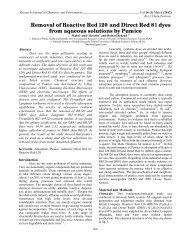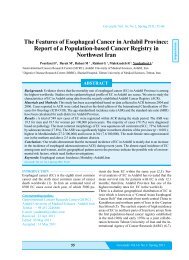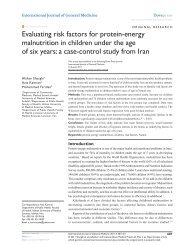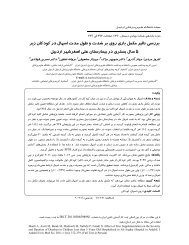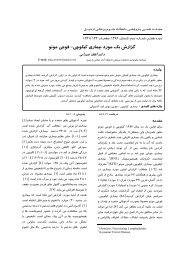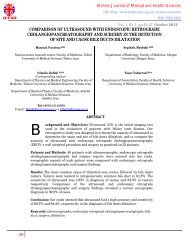Six-month Outcome Predictor Factors of Manic and Mixed Bipolar ...
Six-month Outcome Predictor Factors of Manic and Mixed Bipolar ...
Six-month Outcome Predictor Factors of Manic and Mixed Bipolar ...
Create successful ePaper yourself
Turn your PDF publications into a flip-book with our unique Google optimized e-Paper software.
عوامل پیش بینی کننده پیامد شش...<br />
پرویز مولوي و همکاران 281<br />
<strong>Six</strong>-<strong>month</strong> <strong>Outcome</strong> <strong>Predictor</strong> <strong>Factors</strong> <strong>of</strong> <strong>Manic</strong> <strong>and</strong> <strong>Mixed</strong> <strong>Bipolar</strong><br />
Disorders <strong>of</strong> Children <strong>and</strong> Adolescents Admitted in Tehran Rozbeh<br />
Hospital<br />
Molavi P, MD 1 ; Shahrivar Z, MD 2 ; Mahmodi Garaee J, MD 3 ; Bashirpor S, MSc 4 ,<br />
Sharghi A, MD 5 ; Nikparvar F, MSc 6<br />
1 Associate Pr<strong>of</strong>. <strong>of</strong> Psychiatry Dept. School <strong>of</strong> Medicine, Ardabil University <strong>of</strong> Medical Sciences, Ardabil, Iran.<br />
2 Corresponding Author: Assistant Pr<strong>of</strong>. <strong>of</strong> Psychiatry Dept. School <strong>of</strong> Medicine, Tehran University <strong>of</strong> Medical<br />
Sciences, Tehran, Iran. E-mail:sharivar@sina.tums.ac.ir<br />
3 Assistant Pr<strong>of</strong>. <strong>of</strong> Psychiatry Dept. School <strong>of</strong> Medicine, Tehran University <strong>of</strong> Medical Sciences , Tehran, Iran.<br />
4 PhD C<strong>and</strong>idate <strong>of</strong> Psychology, University <strong>of</strong> Mohaghegh Ardabili, Ardabil, Iran.<br />
5 Assistant Pr<strong>of</strong>. <strong>of</strong> Community Medicine Dept. School <strong>of</strong> Medicine, Ardabil University <strong>of</strong> Medical Sciences,<br />
Ardabil, Iran.<br />
6 MSc <strong>of</strong> Psychology, Shahid Beheshti University, Tehran, Iran.<br />
ABSTRACT<br />
Background & Objectives: <strong>Bipolar</strong> disorder in children <strong>and</strong> adolescents is a childhood critical<br />
disorder with negative course <strong>and</strong> outcome consequences. The aim <strong>of</strong> this study was<br />
determination <strong>of</strong> six-<strong>month</strong> outcome predictor factors (recurrence rate, the rate <strong>of</strong><br />
hospitalization, severity <strong>of</strong> illness <strong>and</strong> recovery rates) in manic <strong>and</strong> mixed bipolar disorders <strong>of</strong><br />
children <strong>and</strong> adolescents admitted in Tehran Rozbeh hospital.<br />
Methods: In this prospective Cohort study, 80 patients with bipolar disorder (10-18 year's old)<br />
admitted in Tehran Roozbeh Hospital from January 2009 to July 2010 were selected. The<br />
available sampling method was used for selection. Participants at admission, discharge, <strong>and</strong><br />
follow-up at 3 <strong>and</strong> 6 <strong>month</strong>s, were evaluated by using researcher made questionnaires, K-<br />
SADS (to confirm the diagnosis), CDI (Children Depression Inventory) or BDI (Beck<br />
Depression Inventory), YMRS (Young Mania Rating Scale), CGI-S (Clinical Global<br />
Impression Scale), CGAS (Children's Global Assessment Scale), CGI-S (Clinical Global<br />
Impression Scale) <strong>and</strong> PAS (Premorbid Adjustment Scale). The data were analyzed by<br />
Pearson correlation coefficient <strong>and</strong> Multivariate regressions.<br />
Results: The results showed that disease outcome was not associated with age. Gender (male)<br />
had correlation with mania severity in 6-<strong>month</strong> follow-up. Disease duration predicted<br />
recurrence rate <strong>and</strong> severity <strong>of</strong> disease. <strong>Manic</strong> type disorder was related with mania severity,<br />
<strong>and</strong> mixed mania predicted mania severity negatively in 6-<strong>month</strong> follow-up. Therapeutic<br />
compliance was correlated with mania severity (negative correlation) <strong>and</strong> improvement rate<br />
(positive correlation). Presence <strong>of</strong> psychosis was correlated with recurrence rate positively in<br />
6-<strong>month</strong> follow-up. Co-morbidity with ADHD (Attention Deficient /Hyperactivity Disorder)<br />
predicted clinical global improvement (CGI-G) negatively <strong>and</strong> mania severity positively in 6-<br />
<strong>month</strong> follow-up. Pre-morbid coping showed negative relationship with mania severity <strong>and</strong><br />
positive relation with global improvement rate in 6-<strong>month</strong> follow-up.<br />
Conclusion: Our results showed that gender <strong>of</strong> patients, duration <strong>and</strong> manic type <strong>of</strong> disease,<br />
presence <strong>of</strong> psychosis at admission have a direct relation with inappropriate outcome <strong>of</strong> manic<br />
<strong>and</strong> mixed bipolar disorders <strong>of</strong> children <strong>and</strong> adolescents. These findings emphasize necessity<br />
<strong>of</strong> special curing during treatment.<br />
Key words: <strong>Bipolar</strong> Disorder; Child; Adolescent




